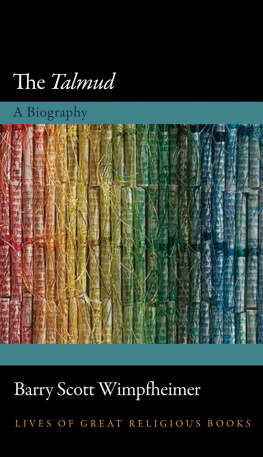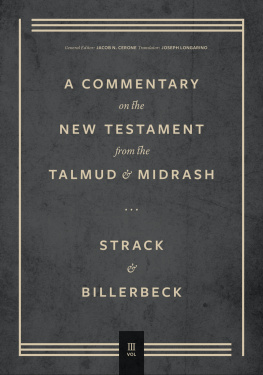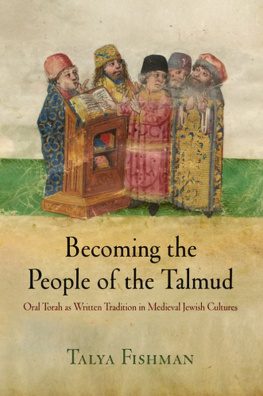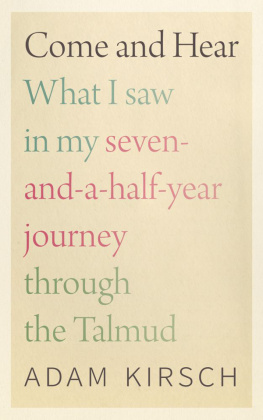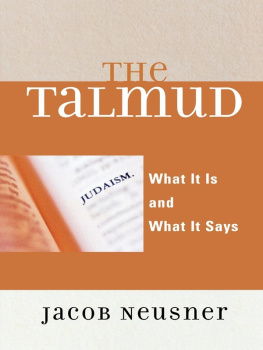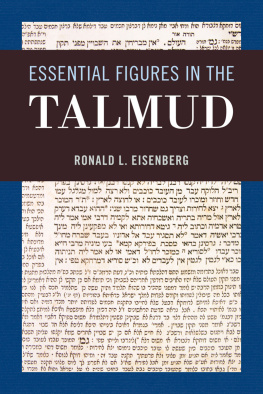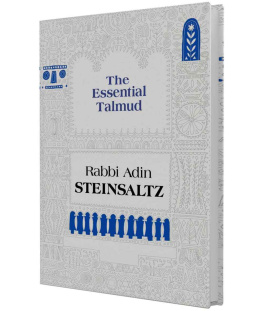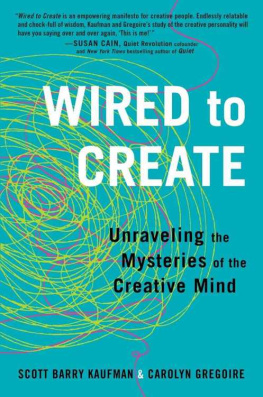Barry Scott Wimpfheimer - The Talmud
Here you can read online Barry Scott Wimpfheimer - The Talmud full text of the book (entire story) in english for free. Download pdf and epub, get meaning, cover and reviews about this ebook. year: 2018, publisher: Princeton University Press, genre: Religion. Description of the work, (preface) as well as reviews are available. Best literature library LitArk.com created for fans of good reading and offers a wide selection of genres:
Romance novel
Science fiction
Adventure
Detective
Science
History
Home and family
Prose
Art
Politics
Computer
Non-fiction
Religion
Business
Children
Humor
Choose a favorite category and find really read worthwhile books. Enjoy immersion in the world of imagination, feel the emotions of the characters or learn something new for yourself, make an fascinating discovery.
- Book:The Talmud
- Author:
- Publisher:Princeton University Press
- Genre:
- Year:2018
- Rating:5 / 5
- Favourites:Add to favourites
- Your mark:
- 100
- 1
- 2
- 3
- 4
- 5
The Talmud: summary, description and annotation
We offer to read an annotation, description, summary or preface (depends on what the author of the book "The Talmud" wrote himself). If you haven't found the necessary information about the book — write in the comments, we will try to find it.
The Talmud — read online for free the complete book (whole text) full work
Below is the text of the book, divided by pages. System saving the place of the last page read, allows you to conveniently read the book "The Talmud" online for free, without having to search again every time where you left off. Put a bookmark, and you can go to the page where you finished reading at any time.
Font size:
Interval:
Bookmark:

LIVES OF GREAT RELIGIOUS BOOKS
The Talmud: A Biography
LIVES OF GREAT RELIGIOUS BOOKS
The Dead Sea Scrolls, John J. Collins
The Bhagavad Gita, Richard H. Davis
John Calvins Institutes of the Christian Religion, Bruce Gordon
The Book of Mormon, Paul C. Gutjahr
The Book of Genesis, Ronald Hendel
The Book of Common Prayer, Alan Jacobs
The Book of Job, Mark Larrimore
The Koran in English, Bruce B. Lawrence
The Lotus Stra, Donald S. Lopez Jr.
The Tibetan Book of the Dead, Donald S. Lopez Jr.
C. S. Lewiss Mere Christianity, George M. Marsden
Dietrich Bonhoeffers Letters and Papers from Prison, Martin E. Marty
Thomas Aquinass Summa theologiae, Bernard McGinn
The I Ching, Richard J. Smith
The Yoga Sutras of Patanjali, David Gordon White
Augustines Confessions, Garry Wills
The Talmud, Barry Scott Wimpfheimer
FORTHCOMING
The Book of Exodus, Joel Baden
The Book of Revelation, Timothy Beal
Confuciuss Analects, Annping Chin and Jonathan D. Spence
The Autobiography of Saint Teresa of Avila, Carlos Eire
Josephuss The Jewish War, Martin Goodman
Dantes Divine Comedy, Joseph Luzzi
The Greatest Translations of All Time: The Septuagint and the Vulgate, Jack Miles
The Passover Haggadah, Vanessa Ochs
The Song of Songs, Ilana Pardes
The Daode Jing, James Robson
Rumis Masnavi, Omid Safi
The Talmud
A BIOGRAPHY
Barry Scott Wimpfheimer
PRINCETON UNIVERSITY PRESS
Princeton and Oxford
Copyright 2018 by Princeton University Press
Published by Princeton University Press,
41 William Street, Princeton, New Jersey 08540
In the United Kingdom: Princeton University Press,
6 Oxford Street, Woodstock, Oxfordshire OX20 1TR
press.princeton.edu
Jacket art: Andi Arnovitz
All Rights Reserved
ISBN 978-0-691-16184-6
Library of Congress Control Number: 2017963018
British Library Cataloging-in-Publication Data is available
This book has been composed in Garamond Premier Pro
Printed on acid-free paper.
Printed in the United States of America
10 9 8 7 6 5 4 3 2 1
For Shana, Adin, and Amalia
CONTENTS
ACKNOWLEDGMENTS
An announcement in a conference schedule about a decade ago alerted me to a new series from Princeton University Press called Lives of Great Religious Books. My instant desire to write a volume for this series on the Babylonian Talmud would take several years to come to fruition. Passing mention of my interest to Daniel Boyarin led to an invitation to pitch my idea for this book to Fred Appel. The rest is history.
I am grateful to those who have helped me with this project. Northwestern University has been my scholarly home for eleven years. I feel tremendous support from the Department of Religious Studies and the Weinberg College of Arts and Sciences. The Crown Family Center for Jewish and Israel Studieswhich I directed while writing this bookis particularly dear to me; thank you to Nancy Gelman, who administers the Crown Center, for freeing up my time to write this book. My colleagues in both Religious Studies and Jewish Studies have been terrific sounding boards for this project and for scholarship in general. I particularly want to thank three colleaguesMira Balberg, Sarah Jacoby, and Michelle Molinawho have often served as a writers collective for this and other projects.
Several friends were very generous with their time and energy and gave me extensive feedback. Thank you to Mira Balberg, Daniel Boyarin, Jeremy Dauber, Shana Gillers, Yohanan Petrovsky-Shtern, and Tzvi Novick for their manuscript annotations and suggested edits. Jonathan Milgram, Daniel Reifman, and Elli Stern are old friends with unique expertise in the Talmud, and their conversations over the years have produced many of the underlying ideas in this book. Sarah Wolf co-taught with me during the period the book was written. Adina Goldman provided valuable research support. Thanks also to Anne Mintz for copyediting and Angela Erisman for indexing.
Family members have encouraged this process. I want to specially thank Susanne and Michael Wimpfheimer, Mina and Bruce Gillers, Jan/Orit, Ahuva/Gershon, David/Rachel, Ben/Tracy, Sara, Chanani/Seth, Yosef/Sara, and their families.
Adin and Amalia have kept me company on this escapade and tolerated those nights on which I couldnt quite let go of the days work. I thank them for cheering me up and distracting me while serving as concrete reminders to keep things in perspective.
Shana is my confidante and partner who has encouraged and critiqued this project since its inception. I am grateful for her love and her company for so many years. In recognition of my inexpressible gratitude, I dedicate this book in her honor and in honor of our children.
LIVES OF GREAT RELIGIOUS BOOKS
The Talmud: A Biography

The TalmudEssential, Enhanced, and Emblematic
PROLOGUE
The Babylonian Talmud can be accurately defined in three distinct ways:
The Babylonian Talmud is a work of religious literature collectively produced by a group of rabbi scholars who lived in two geographic regions (Palestine and Babylonia) between the first and eighth centuries CE.
The Babylonian Talmud is the central canonical work of the Judaism that emerged after the destruction of the Temple in Jerusalem; within an idiosyncratically scholastic culture that relied heavily on texts to ground religious meaning, the Talmud has been the text on which scholars have focused their energies.
The Babylonian Talmud is a uniquely Jewish scripture and has often come to function as the ultimate symbolic representation of Judaism, Jewishness, and Jews.
contains a fuller description of the Talmud itself.)
To understand this notion of multiple registers of meaning, the reader who has not yet encountered the Talmud should consider the biblical Ten Commandments or the United States Constitution as comparable foundational texts. These three texts (the two comparators and the Talmud) were produced in historical time and place. The original meaning of the text is the essential meaning of the text. There are fundamental problems that affect ones ability to confidently recover the original meaning of a text. And yet we can easily comprehend historical meaning as an ideal to which one might strive. This is the first register of Talmudic meaning.
The three texts we are considering are fundamental to ongoing cultural (including legal and religious) practices of reading and have engendered interpretations and applications (to say nothing of explicit amendments) that exponentially expand the work as each original word or sentence generates exegesis, and becomes the basis for inferences and new applications. From its completion (ca. 750 CE) until today, the Talmud has been at the center of an active culture of reading that has generated an enormous literature of reception that understands, interprets, and applies it. This enormous literature is often understood as the Talmud by cultural insiders and should be considered the enhanced Talmud.
Part of what makes the Ten Commandments or the Constitution relevant long after their respective historical moments of production is the potency of their symbolic meaning. This symbolic meaning is sometimes employed without awareness of essential or enhanced meanings and even, occasionally, in contradiction to those meanings. People regularly invoke the Ten Commandments as a symbol of divine legislation and moral justice without knowing the specifics of the commandments themselves. The Constitution is invoked as the basis for liberal democracy and all that is noble about the United States without recourse to its specific words. This book argues that the Talmud also possesses a register of meaning that is only loosely connected with the underlying original content (essential) of the work or the vast apparatus of reception (enhanced). When functioning in this
Next pageFont size:
Interval:
Bookmark:
Similar books «The Talmud»
Look at similar books to The Talmud. We have selected literature similar in name and meaning in the hope of providing readers with more options to find new, interesting, not yet read works.
Discussion, reviews of the book The Talmud and just readers' own opinions. Leave your comments, write what you think about the work, its meaning or the main characters. Specify what exactly you liked and what you didn't like, and why you think so.

